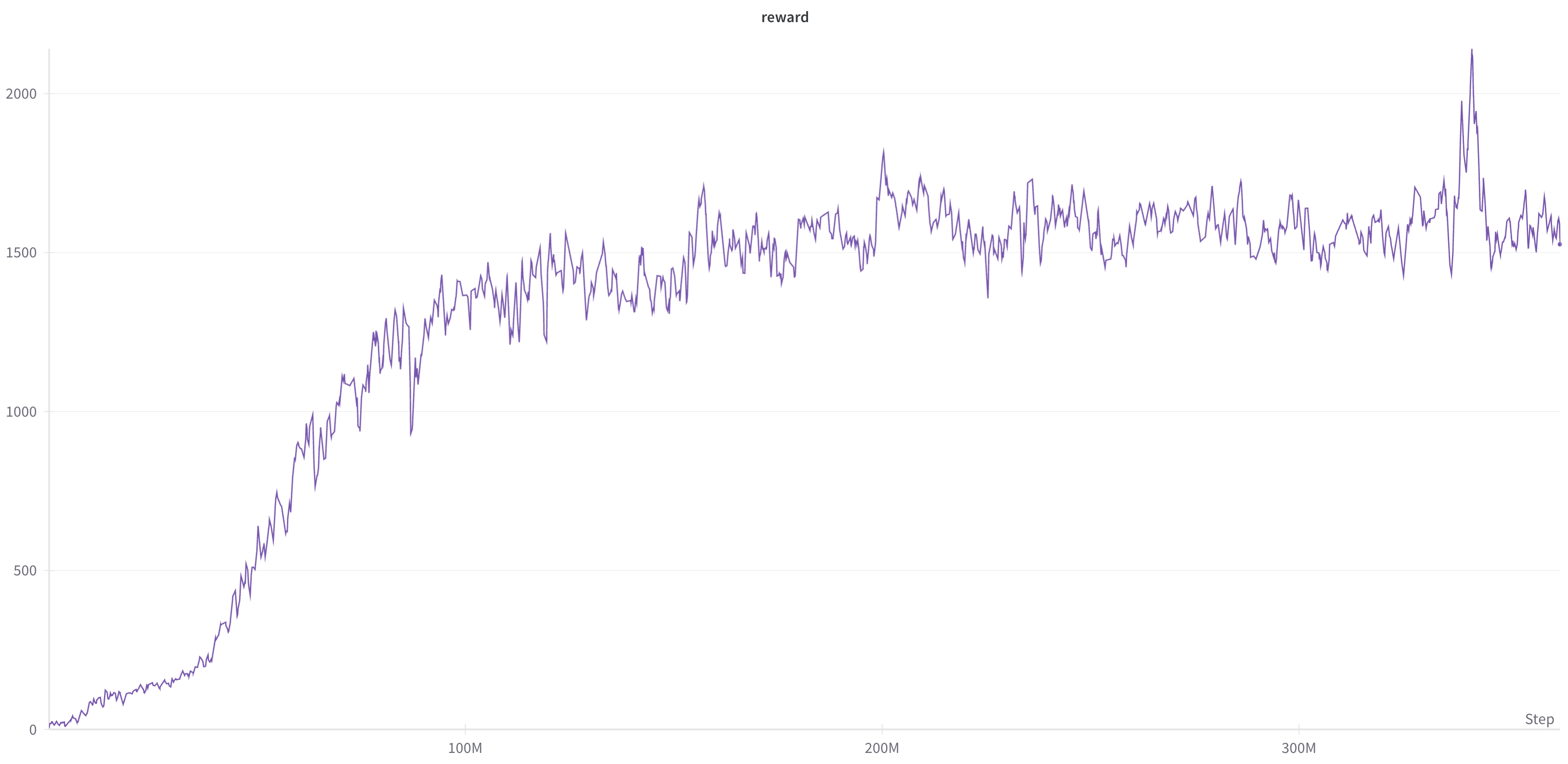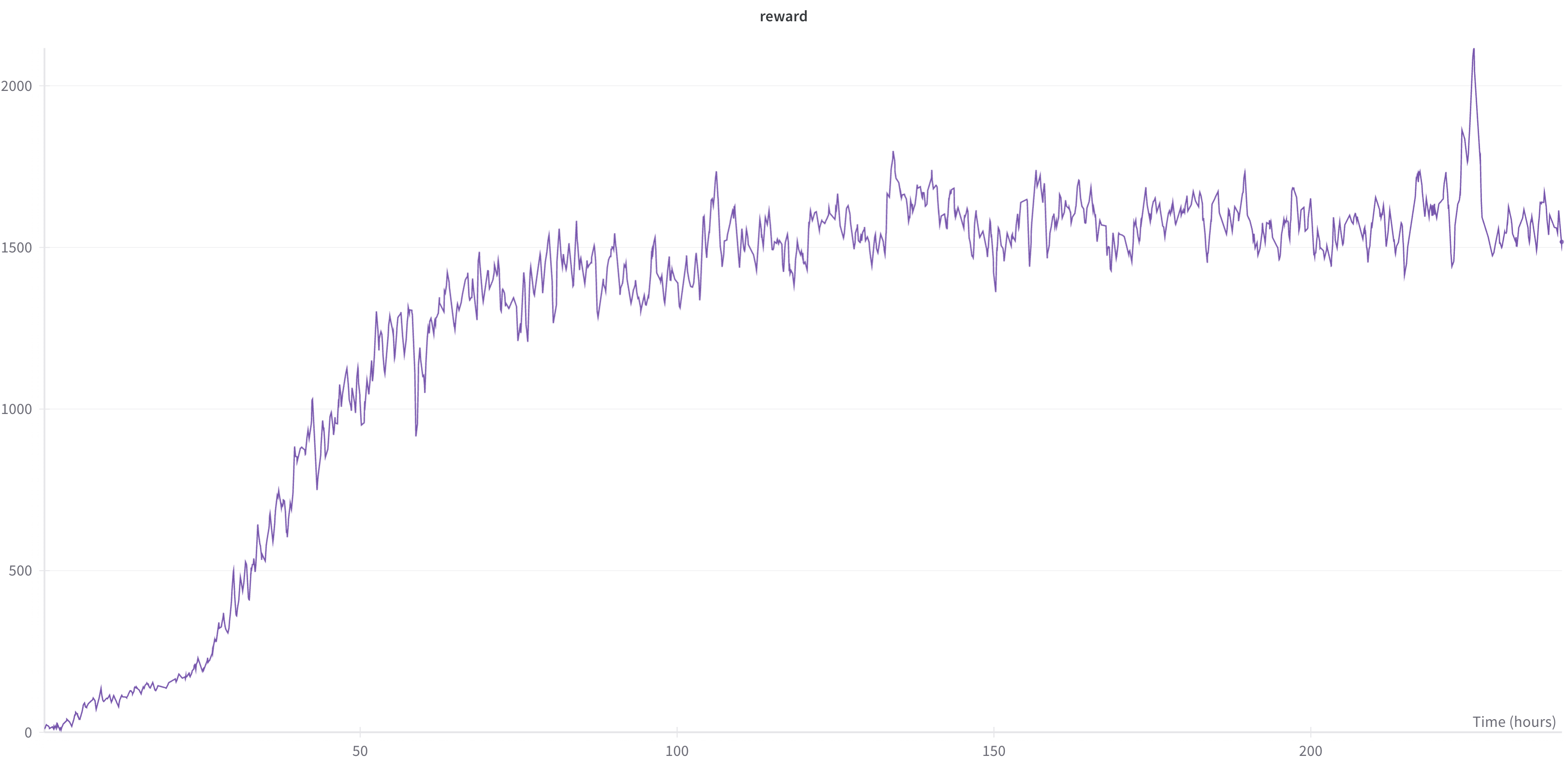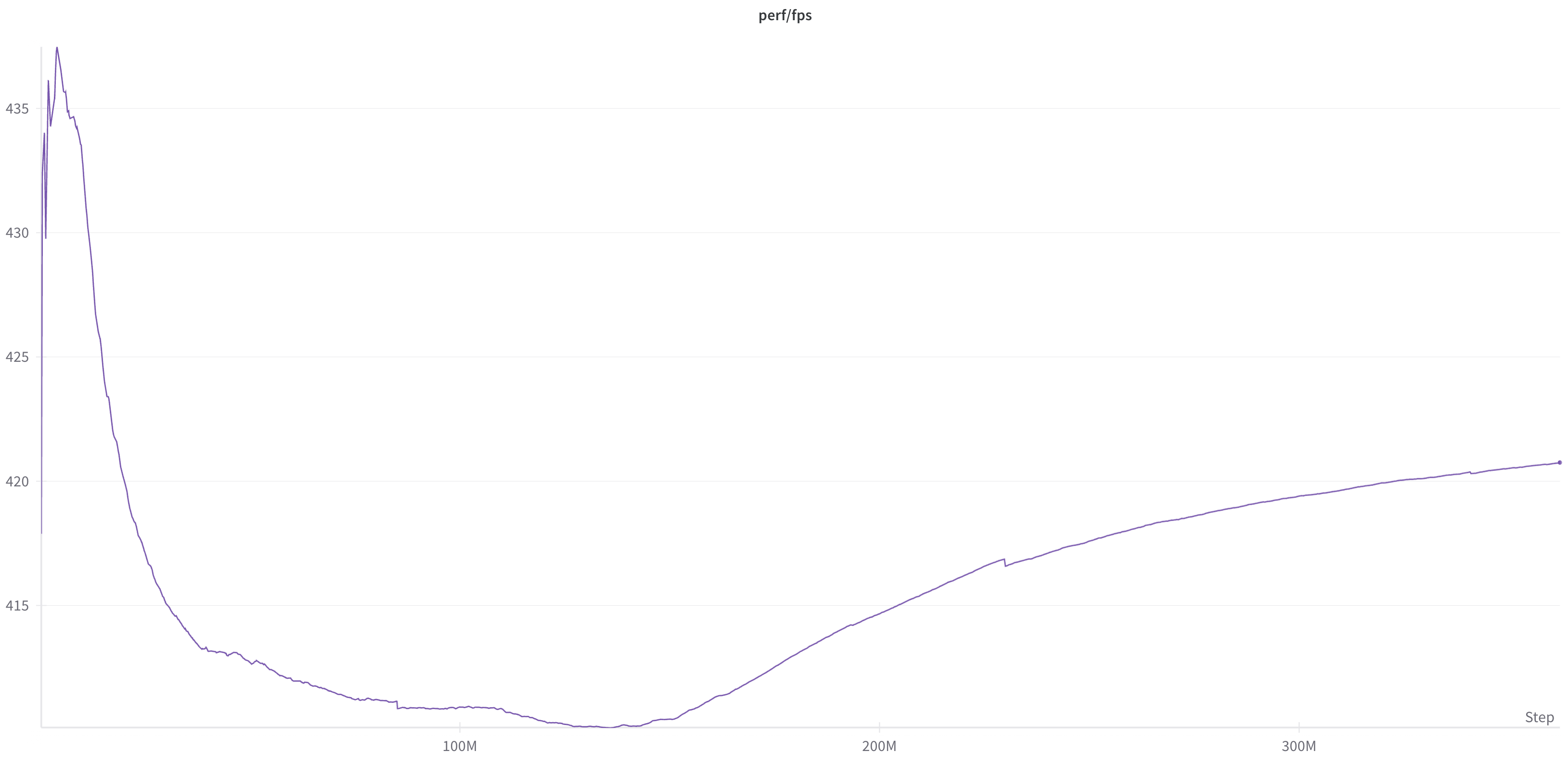The habitat_baselines sub-package is NOT included upon installation by default. To install habitat_baselines, use the following command instead:
pip install -e habitat-lab
pip install -e habitat-baselinesThis will also install additional requirements for each sub-module in habitat_baselines/, which are specified in requirements.txt files located in the sub-module directory.
Proximal Policy Optimization (PPO)
paper: https://arxiv.org/abs/1707.06347
code: The PPO implementation is based on pytorch-a2c-ppo-acktr.
dependencies: A recent version of pytorch, for installing refer to pytorch.org
For training on sample data please follow steps in the repository README. You should download the sample test scene data, extract it under the main repo (habitat-lab/, extraction will create a data folder at habitat-lab/data) and run the below training command.
train:
python -u -m habitat_baselines.run \
--config-name=pointnav/ppo_pointnav_example.yamlYou can reduce training time by changing the trainer from the default implement to VER by
setting trainer_name to "ver" in either the config or via the command line.
python -u -m habitat_baselines.run \
--config-name=pointnav/ppo_pointnav_example.yaml \
habitat_baselines.trainer_name=vertest:
python -u -m habitat_baselines.run \
--config-name=pointnav/ppo_pointnav_example.yaml \
habitat_baselines.evaluate=TrueWe also provide trained RGB, RGBD, and Depth PPO models for MatterPort3D and Gibson. To use them download pre-trained pytorch models from link and unzip and specify model path here.
The habitat_baselines/config/pointnav/ppo_pointnav.yaml config has better hyperparameters for large scale training and loads the Gibson PointGoal Navigation Dataset instead of the test scenes.
Change the /benchmark/nav/pointnav: pointnav_gibson in habitat_baselines/config/pointnav/ppo_pointnav.yaml to /benchmark/nav/pointnav: pointnav_mp3d in the defaults list for training on MatterPort3D PointGoal Navigation Dataset.
We provide a two-layer hierarchical policy class, consisting of a low-level skill that moves the robot, and a high-level policy that reasons about which low-level skill to use in the current state. This can be especially powerful in long-horizon mobile manipulation tasks, like those introduced in Habitat2.0. Both the low- and high- level can be either learned or an oracle. For oracle high-level we use PDDL, and for oracle low-level we use instantaneous transitions, with the environment set to the final desired state. Additionally, for navigation, we provide an oracle navigation skill that uses A-star and the map of the environment to move the robot to its goal.
To run the following examples, you need the ReplicaCAD dataset.
To train a high-level policy, while using pre-learned low-level skills (SRL baseline from Habitat2.0), you can run:
python -u -m habitat_baselines.run \
--config-name=rearrange/rl_hierarchical.yamlTo run a rearrangement episode with oracle low-level skills and a fixed task planner, run:
python -u -m habitat_baselines.run \
--config-name=rearrange/rl_hierarchical.yaml \
habitat_baselines.evaluate=True \
habitat_baselines/rl/policy=hl_fixed \
habitat_baselines/rl/policy/hierarchical_policy/defined_skills=oracle_skillsTo change the task (like set table) that you train your skills on, you can change the line /habitat/task/rearrange: rearrange_easy to /habitat/task/rearrange: set_table in the defaults of your config.
First download the necessary data with python -m habitat_sim.utils.datasets_download --uids hssd-hab hab3-episodes habitat_humanoids hab3_bench_assets.
In the social navigation task, a robot is tasked with finding and following a human. The goal is to train a neural network policy that takes the input of (1) Spot's arm depth image, (2) the humanoid detector sensor, and (3) Spot's depth stereo cameras, and outputs the linear and angular velocities.
The observation of the social nav policy is defined under habitat.gym.obs_keys with the prefix of agent_0 in habitat-lab/habitat/config/benchmark/multi_agent/hssd_spot_human_social_nav.yaml. In this yaml, agent_0_articulated_agent_arm_depth is the robot's arm depth camera, and agent_0_humanoid_detector_sensor is a humanoid detector that returns either a human's segmentation or bounding box given an arm RGB camera. For humanoid_detector_sensor, please see HumanoidDetectorSensorConfig in habitat-lab/habitat/config/default_structured_configs.py to learn more about how to configure the sensor (e.g., do you want the return to be bounding box or segmentation). Finally, agent_0_spot_head_stereo_depth_sensor is a Spot's body stereo depth image.
Note that if you want to add more or use other observation sensors, you can do that by adding sensors into habitat.gym.obs_keys. For example, you can provide a humanoid GPS to a policy's input by adding agent_0_goal_to_agent_gps_compass into habitat.gym.obs_keys in hssd_spot_human_social_nav.yaml. Notice that the observation key in habitat.gym.obs_keys must be a subset of sensors in /habitat/task/lab_sensors. Finally, another example would be adding an arm RGB sensor. You can do that by adding agent_0_articulated_agent_arm_rgb into habitat.gym.obs_keys in hssd_spot_human_social_nav.yaml.
For more advanced users, if you want to create a new sensor for social nav agents, there are three steps.
- Step 1. Define a new sensor config class in
habitat.config.default_structured_configs.py. - Step 2. Based on
typestring you define inhabitat.config.default_structured_configs.py, create the same sensor name in sensor file using@registry.register_sensormethod. See examples inhabitat.tasks.rearrange.social_nav.social_nav_sensors.py. - Step 3. Register the new sensor in
hssd_spot_human_social_nav.yamlfor using it. It should be defined in/habitat/task/lab_sensorsin config yaml, and inhabitat.gym.obs_keysusingagent_0_{your_sensor_name}.
The action space of the social nav policy is defined under /habitat/task/[email protected]_0_base_velocity: base_velocity_non_cylinder in habitat-lab/habitat/config/benchmark/multi_agent/hssd_spot_human_social_nav.yaml. The action consists of linear and angular velocities. You can learn more about the hyperparameters for this action under BaseVelocityNonCylinderActionConfig in habitat-lab/habitat/config/default_structured_configs.py.
The reward function of the social nav policy is defined in social_nav_reward. It encourages the robot to find the human as soon as possible while maintaining a safe distance from the human after finding the human. You can learn more about the hyperparameters for this reward function under SocialNavReward in habitat-lab/habitat/config/default_structured_configs.py.
We have released a checkpoint based on the below command. To reproduce this, run multi-agent training with a Spot robot's policy being a low-level navigation policy and a humanoid's policy being a fixed (non-trainable) policy that navigates a sequence of navigation targets (please make sure the tensorboard_dir, video_dir, checkpoint_folder, eval_ckpt_path_dir are the paths you want):
python -u -m habitat_baselines.run \
--config-name=social_nav/social_nav.yaml \
benchmark/multi_agent=hssd_spot_human_social_nav \
habitat_baselines.evaluate=False \
habitat_baselines.num_checkpoints=5000 \
habitat_baselines.total_num_steps=1.0e9 \
habitat_baselines.num_environments=24 \
habitat_baselines.tensorboard_dir=tb_social_nav \
habitat_baselines.video_dir=video_social_nav \
habitat_baselines.checkpoint_folder=checkpoints_social_nav \
habitat_baselines.eval_ckpt_path_dir=checkpoints_social_nav \
habitat.task.actions.agent_0_base_velocity.longitudinal_lin_speed=10.0 \
habitat.task.actions.agent_0_base_velocity.ang_speed=10.0 \
habitat.task.actions.agent_0_base_velocity.allow_dyn_slide=True \
habitat.task.actions.agent_0_base_velocity.enable_rotation_check_for_dyn_slide=False \
habitat.task.actions.agent_1_oracle_nav_randcoord_action.lin_speed=10.0 \
habitat.task.actions.agent_1_oracle_nav_randcoord_action.ang_speed=10.0 \
habitat.task.actions.agent_1_oracle_nav_action.lin_speed=10.0 \
habitat.task.actions.agent_1_oracle_nav_action.ang_speed=10.0 \
habitat.task.measurements.social_nav_reward.facing_human_reward=3.0 \
habitat.task.measurements.social_nav_reward.count_coll_pen=0.01 \
habitat.task.measurements.social_nav_reward.max_count_colls=-1 \
habitat.task.measurements.social_nav_reward.count_coll_end_pen=5 \
habitat.task.measurements.social_nav_reward.use_geo_distance=True \
habitat.task.measurements.social_nav_reward.facing_human_dis=3.0 \
habitat.task.measurements.social_nav_seek_success.following_step_succ_threshold=400 \
habitat.task.measurements.social_nav_seek_success.need_to_face_human=True \
habitat.task.measurements.social_nav_seek_success.use_geo_distance=True \
habitat.task.measurements.social_nav_seek_success.facing_threshold=0.5 \
habitat.task.lab_sensors.humanoid_detector_sensor.return_image=True \
habitat.task.lab_sensors.humanoid_detector_sensor.is_return_image_bbox=True \
habitat.task.success_reward=10.0 \
habitat.task.end_on_success=True \
habitat.task.slack_reward=-0.1 \
habitat.environment.max_episode_steps=1500 \
habitat.simulator.kinematic_mode=True \
habitat.simulator.ac_freq_ratio=4 \
habitat.simulator.ctrl_freq=120 \
habitat.simulator.agents.agent_0.joint_start_noise=0.0It is expected to observe the following reward training (learning) curve:
 In addition, under the following slurm job batch script setting:
In addition, under the following slurm job batch script setting:
#SBATCH --gres gpu:4
#SBATCH --cpus-per-task 10
#SBATCH --nodes 1
#SBATCH --ntasks-per-node 4
#SBATCH --mem-per-cpu=6GBwe have the following training wall clock time versus reward:

We have the following training FPS:
 Note the training FPS depends on multiple factors such as the number of GPUs and the number of environments.
Note the training FPS depends on multiple factors such as the number of GPUs and the number of environments.
For evaluating the trained Spot robot's policy based on 500 episodes, run (please make sure video_dir and eval_ckpt_path_dir are the paths you want and the checkpoint is there):
python -u -m habitat_baselines.run \
--config-name=social_nav/social_nav.yaml \
benchmark/multi_agent=hssd_spot_human_social_nav \
habitat_baselines.evaluate=True \
habitat_baselines.num_checkpoints=5000 \
habitat_baselines.total_num_steps=1.0e9 \
habitat_baselines.num_environments=12 \
habitat_baselines.video_dir=video_social_nav \
habitat_baselines.checkpoint_folder=checkpoints_social_nav \
habitat_baselines.eval_ckpt_path_dir=checkpoints_social_nav/social_nav_latest.pth \
habitat.task.actions.agent_0_base_velocity.longitudinal_lin_speed=10.0 \
habitat.task.actions.agent_0_base_velocity.ang_speed=10.0 \
habitat.task.actions.agent_0_base_velocity.allow_dyn_slide=True \
habitat.task.actions.agent_0_base_velocity.enable_rotation_check_for_dyn_slide=False \
habitat.task.actions.agent_1_oracle_nav_randcoord_action.human_stop_and_walk_to_robot_distance_threshold=-1.0 \
habitat.task.actions.agent_1_oracle_nav_randcoord_action.lin_speed=10.0 \
habitat.task.actions.agent_1_oracle_nav_randcoord_action.ang_speed=10.0 \
habitat.task.actions.agent_1_oracle_nav_action.lin_speed=10.0 \
habitat.task.actions.agent_1_oracle_nav_action.ang_speed=10.0 \
habitat.task.measurements.social_nav_reward.facing_human_reward=3.0 \
habitat.task.measurements.social_nav_reward.count_coll_pen=0.01 \
habitat.task.measurements.social_nav_reward.max_count_colls=-1 \
habitat.task.measurements.social_nav_reward.count_coll_end_pen=5 \
habitat.task.measurements.social_nav_reward.use_geo_distance=True \
habitat.task.measurements.social_nav_reward.facing_human_dis=3.0 \
habitat.task.measurements.social_nav_seek_success.following_step_succ_threshold=400 \
habitat.task.measurements.social_nav_seek_success.need_to_face_human=True \
habitat.task.measurements.social_nav_seek_success.use_geo_distance=True \
habitat.task.measurements.social_nav_seek_success.facing_threshold=0.5 \
habitat.task.lab_sensors.humanoid_detector_sensor.return_image=True \
habitat.task.lab_sensors.humanoid_detector_sensor.is_return_image_bbox=True \
habitat.task.success_reward=10.0 \
habitat.task.end_on_success=False \
habitat.task.slack_reward=-0.1 \
habitat.environment.max_episode_steps=1500 \
habitat.simulator.kinematic_mode=True \
habitat.simulator.ac_freq_ratio=4 \
habitat.simulator.ctrl_freq=120 \
habitat.simulator.agents.agent_0.joint_start_noise=0.0 \
habitat_baselines.load_resume_state_config=False \
habitat_baselines.test_episode_count=500 \
habitat_baselines.eval.extra_sim_sensors.third_rgb_sensor.height=1080 \
habitat_baselines.eval.extra_sim_sensors.third_rgb_sensor.width=1920The evaluation is expected to produce values similar to those below:
Average episode social_nav_reward: 1.8821
Average episode social_nav_stats.has_found_human: 0.9020
Average episode social_nav_stats.found_human_rate_after_encounter_over_epi: 0.6423
Average episode social_nav_stats.found_human_rate_over_epi: 0.4275
Average episode social_nav_stats.first_encounter_steps: 376.0420
Average episode social_nav_stats.follow_human_steps_after_first_encounter: 398.6340
Average episode social_nav_stats.avg_robot_to_human_after_encounter_dis_over_epi: 1.4969
Average episode social_nav_stats.avg_robot_to_human_dis_over_epi: 3.6885
Average episode social_nav_stats.backup_ratio: 0.1889
Average episode social_nav_stats.yield_ratio: 0.0192
Average episode num_agents_collide: 0.7020Note that in Habitat-3.0 paper, we report our numbers in the full evaluation dataset (1200 episodes). As a result, the number could be a bit different than the ones in the paper.
To run multi-agent training with a Spot robot and humanoid on the social rearrangement task.
- Learn-Single:
python habitat_baselines/run.py --config-name=social_rearrange/pop_play.yaml - Learn-Pop with 8 humanoid policies during training:
python habitat_baselines/run.py --config-name=social_rearrange/pop_play.yaml habitat_baselines.rl.agent.num_pool_agents_per_type=[1,8] - Plan-Pop-4:
python habitat_baselines/run.py --config-name=social_rearrange/plan_pop.yaml habitat_baselines.rl.policy.agent_1.hierarchical_policy.high_level_policy.plan_idx=4. To run Plan-Pop-p for otherpvalues, sethabitat_baselines.rl.policy.agent_1.hierarchical_policy.high_level_policy.plan_idx.
For zero-shot evaluate against the unseen agent population:
- With planner-based collaborators:
python habitat_baselines/run.py --config-name=social_rearrange/pop_play.yaml habitat_baselines.evaluate=True habitat_baselines.eval_ckpt_path_dir=PATH_TO_CKPT.pth +habitat_baselines.rl.policy.agent_1.hierarchical_policy.high_level_policy.select_random_goal=False +habitat_baselines.rl.policy.agent_1.hierarchical_policy.high_level_policy.plan_idx=1changeplan_idxto be 1, 2, 3, or 4 to evaluate against the other 4 planner agents.